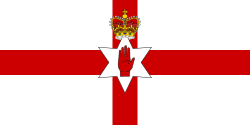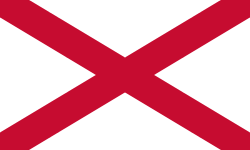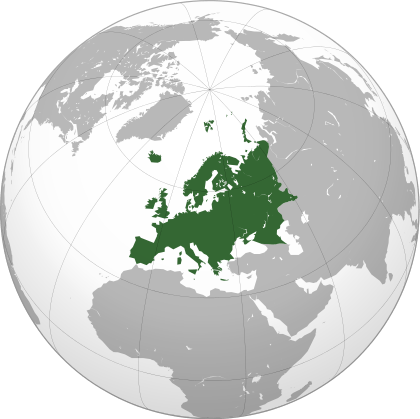Flag of Northern Ireland
The official flag of Northern Ireland is the Union Flag of the United Kingdom. From 1953 until 1973 the Ulster Banner (also known as the Ulster flag) was used, however since then its use has been limited to representing Northern Ireland in certain sports, at the Commonwealth of Nations, at some local councils, and at some other organisations and occasions. Despite this the Ulster Banner is still commonly seen and referred to as the flag of Northern Ireland especially by those from the unionist and loyalist communities.
The Saint Patrick's Saltire represents Northern Ireland indirectly as Ireland in the Union Jack. It is sometimes flown during Saint Patrick's Day parades in Northern Ireland,[1] and is used to represent Northern Ireland during some royal events.[2]
In recent years there have been calls for a new, neutral flag for Northern Ireland.[3][4]
Flag of the Government of Northern Ireland (1924–1973)
The Ulster Banner, also known as the "Red Hand Flag" or the "Ulster Flag" (not to be confused with the provincial Flag of Ulster), was the flag that was granted a royal warrant for use to the Government of Northern Ireland in 1924. In common with other British flags, any civic status of the flag was not defined in law.[5]
The Government of Northern Ireland was granted arms (the Coat of arms of Northern Ireland) by Royal Warrant and had the right to display these arms on a flag or banner. This right was exercised for the Coronation in 1953 when the banner was flown for the first time over Parliament Buildings in honour of the Queen's visit. Also during the Queen's visit, on July 1, 1953, the Minister for Home Affairs announced that, while the Union flag was the only standard officially recognised, those who wished to have a distinctive Ulster symbol might use the banner.[6] When the Parliament of Northern Ireland was dissolved by the British government under the Northern Ireland Constitution Act 1973, the flag ceased to be used by a body with a royal warrant but remains the only flag to date which represents Northern Ireland at international level in sport.[5]
Since the Northern Ireland government and parliament were abolished in 1972, use of the Ulster Banner among loyalists has increased.[7][8]
Official use of flags
There are various practices for the flying of flags by public bodies in Northern Ireland. The Flags Regulations (Northern Ireland) Order 2000 requires that the Union Flag be flown over specified government buildings including Parliament Buildings and state offices on specified 'named days' (honouring, for example Queen Elizabeth II's official birthday).
The regulations also provides that, on the occasion of a visit to a government building by the British Monarch, the Royal Standard shall be flown and the Union Flag can be flown, and on state visits from other heads of state the Union Flag and the national flag of the country of the visitor can be flown. Where two flagpoles exist, the flag of Europe should be flown on Europe Day alongside the Union flag. The regulations prohibit any flags being flown from the relevant buildings except as expressly permitted by the regulations.[9]
When flags representing the "Home Countries" of England, Northern Ireland, Scotland and Wales are flown at official ceremonies, Northern Ireland is sometimes represented by the St. Patrick's Cross, for instance on the barge Gloriana during the 2012 Thames Diamond Jubilee Pageant.[10] In May 2016 the Ulster Banner was flown from horseback during the Musical Ride of the Household Cavalry at The Queen's 90th Birthday Celebration at Windsor, alongside the flags of England, Scotland and Wales.[11][12]
Other regulations exist for other public bodies in Northern Ireland. Use of flags by the Police Service of Northern Ireland is governed by the Police Emblems and Flags Regulations (Northern Ireland) 2002, which provides that no flag shall be used by the Service other than its own flag.
Local authorities
Legislation relating to flag flying does not apply to District Council buildings, and District Councils follow a range of practices varying from flying the Union Flag on a number of council buildings every day of the year as at Lisburn, to flying no flags on any building, flying only the council flag or flying flags on the designated days in the same way as government buildings.[13]
In 2004, Belfast City Council commissioned a study on the flying of the Union Flag which noted that the Ulster Banner was flown alongside it by three unionist-controlled district councils at that time: Ards Borough Council, Carrickfergus Borough Council and Castlereagh Borough Council.[14] These councils have since been replaced.
International sport
In sport, the Ulster Banner is carried by the Northern Ireland team in the Commonwealth Games.[15] It is also regularly displayed by supporters of the Northern Ireland national football team and is displayed by FIFA as the flag of Northern Ireland.[16][17]
Displaying flags
In Northern Ireland, some members from each of the unionist and nationalist communities use flags to declare their political allegiances and to mark territory.[18] Unionists and loyalists fly the Union Flag and Ulster Banner to show their support for the union and/or their allegiance to Northern Ireland. Irish nationalists and republicans fly the Irish tricolour to show their support for a United Ireland.[19]
Peace process
After the 1998 Good Friday Agreement, flags continue to be a source of disagreement in Northern Ireland. The Agreement states that:
All participants acknowledge the sensitivity of the use of symbols and emblems for public purposes, and the need in particular in creating the new institutions to ensure that such symbols and emblems are used in a manner which promotes mutual respect rather than division.[20]
Nationalists pointed to this to argue that the use of the Union Flag for official purposes should be restricted, or that the Irish tricolour should be flown alongside the British flag on government buildings. Sinn Féin ministers in the power-sharing Northern Ireland Executive instructed that the Union Flag was not to fly from buildings operated by their respective departments.[21] This power was removed from ministers by virtue of the Flag Regulations (Northern Ireland) Order 2000, mentioned above.
All signatories to the Belfast Agreement also declare their acceptance of the 'principle of consent' (i.e. that there will be no change to the constitutional position of Northern Ireland unless a majority votes for it), and Unionists argued that this provision amounts to recognising that the Union Flag is the only legitimate official flag in Northern Ireland. The problem was discussed in detail and various proposals made including suggestions for a new flag.[22]
In 2013, US diplomat Richard Haass chaired talks between the political parties in Northern Ireland dealing with, among other things, the issue of flags. The resulting draft proposals, which were not agreed by the parties, included the idea of a new flag for Northern Ireland, to replace the Ulster banner.[23]
See also
References
- ↑ Groom, Nick (2007). "Union Jacks and Union Jills". In Eriksen, Thomas Hylland; Jenkins, Richard. Flag, Nation and Symbolism in Europe and America. Abingdon: Routledge. pp. 68–87. ISBN 0-415-44404-7. LCCN 2007018505. OCLC 123968978. OL 9353071W.
- ↑ Bartram, Graham (2012). "A Visual Guide to the Flags used in the Thames Diamond Jubilee Pageant" (PDF). Flag Institute. p. 5. Archived from the original (PDF) on 7 March 2014. Retrieved 22 August 2015.
- ↑ "New Northern Ireland flag should be created, says Lord Kilclooney". The News Letter. 17 December 2013.
Lord Kilclooney, the former Ulster Unionist deputy leader, is a vice chairman of Westminsters all-party group on flags and heraldry which promotes the flying of the Union Flag. He told the News Letter […] ‘whilst England (St George’s Cross) Scotland (St Andrew’s Cross) and Wales (The Dragon) have individual regional flags, the Flags Institute in London confirms that Northern Ireland has no official regional flag’.
- ↑ "Find a neutral flag for all of Northern Ireland: Richard Haass issues challenge to parties". Belfast Telegraph. 3 December 2013.
- 1 2 Encyclopaedia Britannica says: 'According to British tradition, a coat of arms or flag is granted to the government of a territory, not to the people residing there. Therefore, when the government of Northern Ireland was disbanded in March 1972, its arms and flag officially disappeared; however, the flag continues to be used by groups (such as sports teams) representing the territory in sport.'
- ↑ McCartney, Clem & Bryson, Lucy. Clashing Symbols? A report on the use of flags, anthems and other national symbols in Northern Ireland. The Institute for Irish Studies, Queen's University of Belfast, 1994,p. 42 ISBN 085-389-538-4
- ↑ Morris, Ewan (2005). Our Own Devices: National Symbols and Political Conflict in Twentieth-century Ireland (New Directions in Irish History). Irish Academic Press Ltd. p. 205. ISBN 978-0716533375.
The main change to the use of symbols within the unionist community in recent decades has been the growing popularity of the Northern Ireland flag since the early 1970s, when it came into widespread use by loyalists who felt that they had been betrayed by the government at Westminster. The increasing use of the Northern Ireland flag has sometimes been seen as symptomatic of a growing sense of Ulster nationality...
- ↑ Ward, Paul (15 April 2004). Britishness Since 1870. Routledge. p. 166. ISBN 978-0415220170.
From the early 1970s some unionists have sought increasingly to stress their identity with Ulster [...] Since the 1970s the use of the Northern Ireland flag has become prominent, further emphasising the desire to stress an Ulster identity.
- ↑ The Flags Regulations (Northern Ireland) 2000
- ↑ Bartram, Graham (2012). "A Visual Guide to the Flags used in the Thames Diamond Jubilee Pageant" (PDF). The Flag Institute. p. 5. Archived from the original (PDF) on 8 November 2012. Retrieved 6 April 2016.
- ↑ Northern Ireland's flag flown on horseback during the Queen's 90th birthday celebrations on 15th May 2016 - from 59m:50s, YouTube Mirror
- ↑ The Queen's 90th Birthday Celebration, Souvenir Programme, Regal Press Ltd, 2016 p 12, ISBN 9781906670405
- ↑ Transforming Conflict: Flags and Emblems by Dominic Bryan and Gordon Gillespie, Institute of Irish Studies, Queen's University, Belfast, March 2005
- ↑ Belfast City Council (May 2004), Flying of the Union Flag: An Equality Impact Assessment. Archived 15 June 2007 at the Wayback Machine.
- ↑ Northern Ireland Commonwealth Games Brand Identity Guidelines
- ↑ Northern Ireland at UEFA
- ↑ Northern Ireland at FIFA
- ↑ Dominic Bryan & Gordon Gillespie (2005) Transforming Conflict: Flags and Emblems, Belfast: Institute of Irish Studies, Queens University Belfast
- ↑ The National Flag, Department of the Taoiseach
- ↑ Belfast Agreement, section: "Economic, Social and Cultural Issues", para. 5
- ↑ Tension over flag flying at BBC News
- ↑ Flagging concern: the controversy over flags and emblems Archived 10 April 2005 at the Wayback Machine.
- ↑ http://www.irishtimes.com/news/ireland/irish-news/haass-proposes-new-body-to-investigate-troubles-killings-1.1629610
External links
| Wikimedia Commons has media related to Flags of Northern Ireland. |
| Wikimedia Commons has media related to Proposed flags of Northern Ireland. |
- FOTW: Northern Ireland
- CAIN: Flags in Northern Ireland
- The Union Flags and flags of the United Kingdom



